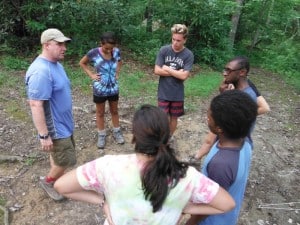In Part 1 of this series, we told you about the unique curriculum offered here at The National Center for Outdoor & Adventure Education (NCOAE) and the fact that its focus is much more than just developing outdoor skills for our students and adult course participants.

In addition to teaching how to best use nimble feet and hands to ascend a rock face, or selecting the best route around a car-sized boulder in the middle of a fast-moving river, we also like to put the educational emphasis on humanism. And empathy. And self-analysis. To encompass these traits entails mastering the skills of leading, listening and learning.
So, for this — the second installation in our series of blog posts about the NCOAE curriculum — we begin to delve into each one of our 11 Ed Group topics. And we’re going to do that in depth. In fact, we’re going to cover these topics three at a time. That way, we can take our time, explain the topics, and not overwhelm anyone.
As a refresher, at NCOAE, “Ed Group” is short for Educational Group. Our wilderness programs expose course participants to a core curriculum built upon Self, Community, Action and Impact. We factor in 11 topics to be addressed during the daily Ed Groups, and these same 11 topics are revisited for reflection during evening Process Groups (known as “The Summit”). We also have Feelings Check Ins regularly. Each day — sometimes multiple times a day — we have the group circle up for a quick ‘Feelings Check In’, which in one or two words describes how one feels. For example, we typically have one Feelings Check In before starting an activity such as hiking or climbing.
Feelings Identification: Accurately identify our feelings is the foundation on which our curriculum is built upon. During the Feeling Identification group we establish a list of feeling words in order to have productive expression of feelings in the future. The long-term objective here is for folks to instinctively identify primary rather than secondary emotions. Here at NCOAE, we find that distinguishing between primary and secondary emotions is helpful when trying to resolve conflict, communicate personal needs, or manage risks. Here is the skinny on the two:
Imagine the layers of an onion. The inside is the core, where you often find the harder to pinpoint feelings such as pride, loneliness or shame. On the outside is happy, mad or sad which are actually secondary feelings but the ones folks can easily/typically label or pinpoint.
By the end of Feelings Identification group we list over 75 “feeling words” to be used through out the NCOAE course and at home. This list is used later during the Defense Mechanism, Stress Management, and Clear Communication and Conflict Resolution Ed Groups.
Levels of Communication/Relationships: With this Ed Group topic, students explore the stages of relationships, along with levels of communication and boundaries.
Here we use a bulls eye to represent the different levels of communication and relationships. First, we ask course participants to examine the layers in their journal, and soon thereafter the group is standing on a life size bulls eye and walking through the layers together. Processing concerns and benefits on each level. Deeper discussion follows during evening Summits (note: the Summit is the platform we employ for processing and reflecting on the day’s adventure experiences and Ed Group topics).
Defense Mechanisms: To prepare for this Ed Group topic, students write down the type of animal that best represents them in their journal, then describe how it acts when threatened and what behavioral instincts take over that help the animal survive.
During Feelings Identification Ed Group, course participants are encouraged to investigate feelings that are harder to pinpoint in order to better manage upsetting situations. The next phase in conflict resolution is to be prepared and have insight about our instinctual (yet not necessarily helpful) responses to stress. Together, group members establish a list of common and sometimes harmful ways people deal with pain. It is important that participants not “beat themselves up” for using defense mechanisms. They are, after all, a part of our DNA.
This exercise concludes with students writing down a defense mechanism they might have used in the past that didn’t work out so well. Then they rewrite the same situation, only with a positive ending — one in which a defense mechanism was not necessary by approaching the situation differently.
Next time, we’ll tackle three more Ed Group topics. Stay tuned!
TALK TO US
Have any further questions about our courses, what you’ll learn, or what else to expect? Contact us, we’re here to help!
Leave a comment